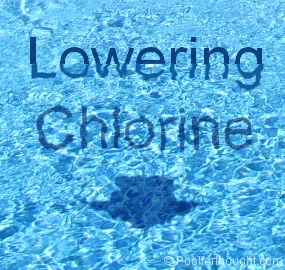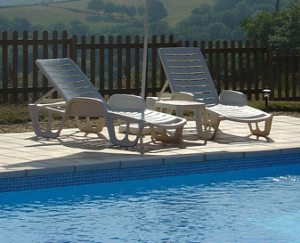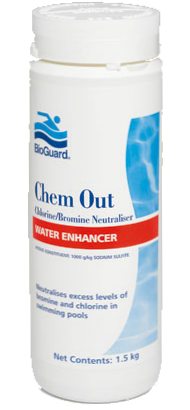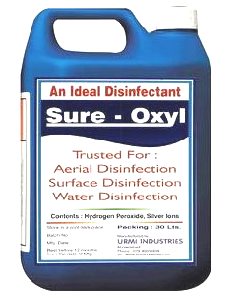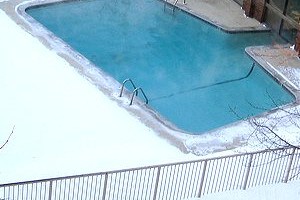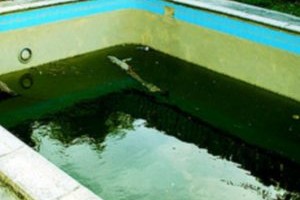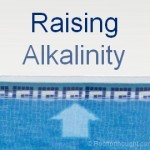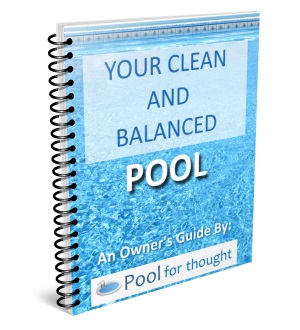In this article, I explain how to lower the chlorine level in your swimming pool water. If you would like to learn more about chlorine in your swimming pool, read Maintaining Swimming Pool Chlorine. I have also written an article about how to test your swimming pool chlorine, and if you find your chlorine is too low, you can learn how to Raise Your Swimming Pool Chlorine.
Importance for your pool
Why is lowering swimming pool chlorine important?
When maintaining a swimming pool, you typically will be spending more time raising the chlorine level more often than trying to lower the chlorine. However, there are times you might discover after testing your chlorine level that it is too high and you need to lower it. You do not want to entirely strip the pool of chlorine, but bring the chlorine down to safe levels for swimmers and at a level where the pool water is comfortable for swimmers and does not harm pool equipment, yet has adequate sanitation capability for swimmers.
The recommended range for residential pools is 1 – 3 ppm (parts-per-million) of chlorine in the water.
If pool chlorine level is too high:
- Swimmer irritation. High chlorine stings eyes and nasal passages. Be aware that swimmer irritation can be caused by more than just high chlorine, although this is the first thing people often think of when their eyes sting after swimming. Unbalanced pool water will also irritate swimmers, so you need to check the pH, total alkalinity, and calcium hardness of your water as well.
- Unneeded chemical expense. Chlorine is expensive, and adding too much unnecessarily is just added expense and time. You also risk ending up with unbalanced pool water, which will take additional chemical and time to bring the water back into balance.
- Bleaching of clothes. Just like liquid household bleach whitens whites, too much chlorine can degrade the color of swimsuits, towels, and any dyed material exposed to the pool water.
I also discuss reasons to decrease the chlorine level in my other article:
To avoid high levels of chlorine, add smaller amounts of chlorine, and then retest. Getting a chlorinator or chlorine feeder is another great option, as you can set the water flow through the device, as well as vary the amount of chlorine in the chlorinator. After a few chemical additions and testing, you will find you can maintain your chlorine level fairly consistently.
Why is my pool chlorine level too high?
You may have shocked the pool water, which if done correctly should result in a very high chlorine level, likely greater than 10 ppm. You need to let the shock oxidize and sanitize the pool water, usually at least 8 hours before attempting to lower the chlorine.
You may have had your chlorinator, chlorine feeder, or chlorine floater set too high or have added too much chlorine to the device, resulting in the chlorine level drifting higher over time.
With less heat, sunlight, and bather load, the pool water requires less free chlorine in the water, as the chlorine demand has lessened.
How to Lower Swimming Pool Chlorine
First test your chlorine level.
Testing will determine the severity of the problem. Are you just over the upper limit of 3 ppm? If you are at 4 ppm level for example, you are best off just leaving your pool open until the guests arrive. In a couple hours of direct sunlight, the level should have dropped enough. If you have just shocked the pool, you may find your level much higher, at this point you may have to consider adding a neutralizing chemical.
Next, stop adding chlorine.
This may seem obvious, but if you need to first turn off your chlorinator/chlorine feeder if you have one so you are not adding additional chlorine. You do not need to remove the chlorine tablets, as if the flow is turned off, then no chlorine will enter the pool. If you use a chlorine floater, make sure it is empty or remove it from the pool.
Lower pool chlorine by doing nothing
Hot, windy, sunny, summer weather constantly blowing in small amounts of dirt and debris, along with multiple pool gatherings with many swimmers are all things that end up reducing the chlorine level in the pool water. If your chlorine level is not that high over the ideal range (3 ppm), then this is your best bet.
Decrease pool chlorine with natural sunlight
The next way is to make sure your pool cover is off if you have one, and let the sunlight shine on your pool. Sunlight depletes chlorine level, although not as fast as chemical methods. On a cloudless sunny day, 90% of the chlorine level in a pool can be destroyed in about two hours.
Lessen pool chlorine with a chlorine neutralizing chemical
Several chemicals exist that will reduce the chlorine in your pool. If, for example, you are having guests arriving within a short amount of time and they plan to use the pool, then reducing the chlorine with a chemical neutralizer is your best option. The key is to follow the directions exactly from the product label, or you risk stripping your pool completely of chlorine.
…using Sodium thiosulfate
Sodium thiosulfate is another chemical that can be used to reduce your pool chlorine level, with sodium sulfite, sodium bisulfite, and sodium metasulfite being variations. We recommend you ask your pool chemical provider for “chlorine neutralizer”, and they will direct you to the best product for your needs. A drawback to any of these chemicals is a significant reduction in pH. So, you need to test your pool water pH before and after adding this to determine if you need to add pH increaser to raise the pH level.
…using Hydrogen Peroxide
Hydrogen Peroxide is another chemical that can lower chlorine. You would need to purchase hydrogen peroxide designated for use in pools, as the variation typical found in retails stores meant for human use is not strong enough. Hydrogen peroxide will reduce your chlorine at pH levels higher than 7, which your pool should be at if your water is balanced. If your pool pH is less than 7.0, then hydrogen peroxide is much less effective. In our opinion, if your pool pH is this far off, then you need to address the low pH first.
Keep in mind that if you destroy the chlorine in your pool with a chemical, the cyanuric acid level will remain the same. The next time you add chlorine, which trichlor tablets and other stabilized chlorines have, your cyanuric acid level will rise. You should test for cyanuric acid often. All the chemicals we listed reduce your pH level somewhat as well, which you want to avoid pH levels that are too low.
Lowering pool chlorine by replacing existing pool water
You can also reduce the chlorine level by replacing some of your pool water. There are several drawbacks to this method, however. The first is time. It will take some time to partially drain a pool and even more time to fill it. The second is cost. With many municipal water sources charging tiered rates, you can easily run your water usage into a 2nd or 3rd water pricing tier, significantly increasing the cost of water added to your pool. The third is you could throw your water out of balance, as pH, alkalinity, calcium hardness, and many other levels out of balance, causing more testing an more chemical expense. If your chlorine is high and you were going to backwash the sand filter, then this would be one reason to replace some of the water. Another reason is if you had other levels too high, such as total dissolved solids, copper, or cyanuric acid levels.
No matter which way you choose, always retest your chlorine level after you intentionally lower the chlorine.
Conclusion
Don’t remove all the chlorine, only the minimum to bring the level down to normal levels.
Sunlight shining on the pool water will remove chlorine naturally. If you have enough time before you want to use the pool again, I recommend keeping the cover off for an afternoon, preferably with low wind and with plenty of sun. If you do not have time, then adding a chemical is an option, but you have to be aware of the risks of adding chlorine neutralizers and their effect on the water balance of your pool.
Sources:
- “Pool & Spa Water Chemistry, A Testing and Treatment Guide, Waterproof Edition, 2005. Taylor”
- https://www.portal.state.pa.us/portal/server.pt/community/environmental_health/14143/fact_sheet_on_cyanuric_acid_and_stabilized_chlorine_products/556676
- https://www.fmcchemicals.com/Portals/chem/Content/Docs/H2O2%20Documents/Dechlorination_with_H2O2.pdf
Photo credits:
- Hose/water photo by DanielleSaysHello, at flickr.com.
- Sun photo by gr33n3gg, at flickr.com.
- Chair/pool photo by lapeyrecout,at flickr.com.
